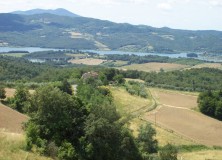Art and Territory
The Mugello valley, is a depression that starts to form 10 million years ago, when the Tuscany’s sediments began to suffer compression, which caused the uplift of the crust in several areas, forming large folds and dams, and giving rise to lake basins, during the Pliocene’s age, that normal erosion of the rivers could not counter.
So are formed the plain between Florence and Pistoia, and the plains of the Mugello, the Casentino, the Val di Chiana, and the Val Tiberina; and also the val d’Arno, where are still visible in the Rignano area, signs of the clay layer, blocking the flow of water and debris of the Arno river.
Mugello is crossed by the river Sieve, is closed to west by the Calvana mountains, to the north by the Apennines massive, crossed by the Futa pass, and following eastward by the passes of Giogo of Scarperia, Colla di Casaglia, and Muraglione on the St. Benedict Alps. To the south there is a massif that separates the plain of Florence and the Arno valley in which the highest peak, Mount Giovi, is below 1000 meters high.
The Sieve River to south west until Pontassieve, where meets the Arno, becoming its main tributary before reaching Florence.
There is a varied vegetation, according on the altitude. In the plains and up to 400 meters there are vineyards and olives, over the 400 meters start the chestnut trees, the oaks and hornbeam. Over 900 meters meet the beeches and firs.
The climate is considered transition, relatively mild.
The first traces of human presence dating back to the Neolithic Age, According to some scholars, the name comes from the tribe of Magelli that belonged to the people of Ligurians, but the first massive civilization in the area was done by the Etruscans, culminated in the second century BC, with the conquest by the Romans; and they built two important roads of communication between Emilia and Tuscany the first linked Faenza to Lucca, and the second connected Florence to Ravenna.
After the Lombard invasion, several fortifications and castles to defend the territory were built, that later became feudal’s headquarters. After the time of the free municipalities, the Mugello became one of the areas under the Florentine’s influence, at that period Borgo San Lorenzo and Scarperia have had a good development and economic growth.
